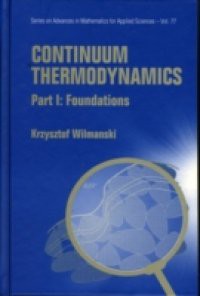This book is a unique presentation of thermodynamic methods of construction of continuous models. It is based on a uniform approach following from the entropy inequality and using Lagrange multipliers as auxiliary quantities in its evaluation. It covers a wide range of models — ideal gases, thermoviscoelastic fluids, thermoelastic and thermoviscoelastic solids, plastic polycrystals, miscible and immiscible mixtures, and many others. The structure of phenomenological thermodynamics is justified by a systematic derivation from the Liouville equation, through the BBGKY-hierarchy-derived Boltzmann equation, to an extended thermodynamics. In order to simplify the reading, an extensive introduction to classical continuum mechanics and thermostatics is included. As a complementary volume to Part II, which will contain applications and examples, and to Part III, which will cover numerical methods, only a few simple examples are presented in this first Part. One exception is an extensive example of a linear poroelastic material because it will not appear in future Parts.The book is the first presentation of continuum thermodynamics in which foundations of continuum mechanics, microscopic foundations and transition to extended thermodynamics, applications of extended thermodynamics beyond ideal gases, and thermodynamic foundations of various material theories are exposed in a uniform and rational way. The book may serve both as a support for advanced courses as well as a desk reference.Contents:IntroductionGeometryKinematicsBalance EquationsSecond Law of ThermodynamicsEquilibrium Gibbs ThermodynamicsKinetic TheoriesExtended ThermodynamicsThermodynamical Model of Viscoelastic MaterialsElasto-viscoplastic MaterialsThermodynamics of Miscible MixturesThermodynamics of Immiscible Mixtures: Introduction and Models Without the Field of PorosityThermodynamics of Poroelastic Materials with the Balance Equation of PorosityFinal RemarksAppendices:Vectors and Tensors on Euclidean SpacesBasic Physical UnitsReadership: Thermodynamicists, materials scientists and physicists.

